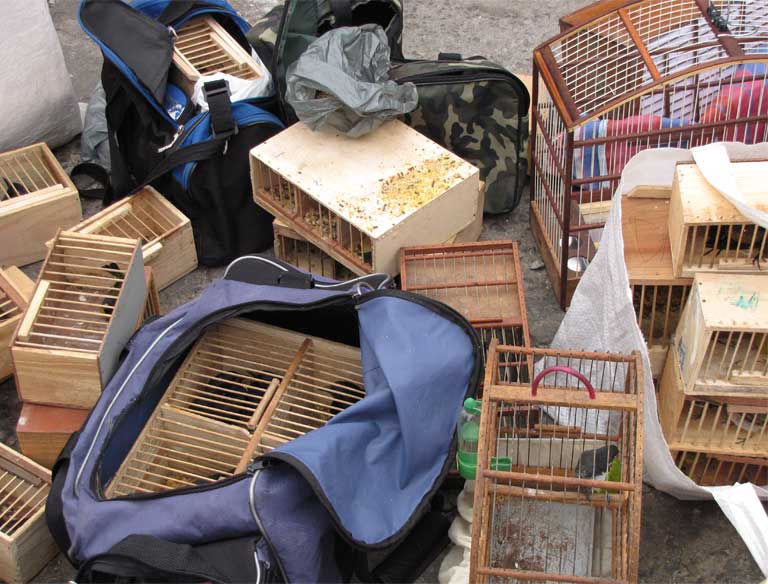- Brazil possesses extraordinary biodiversity, which makes it a place in which wildlife traffickers thrive, earning US $2 billion annually, while draining wild lands of tropical birds, fish, turtles, snakes and mammals in unsustainable numbers.
- While the country has strong wildlife protection laws, these are very poorly enforced, and a legal loophole, allowing 1,000 licensed wildlife breeders to operate, results in animals being captured illegally and “laundered” by captive breeders.
- “To turn the tide on [trafficking] of this magnitude, a global response is going to have to be much better — and all possible support needs to be provided to the countries… on the front lines,” said Helen Clark, Administrator for the UN Development Programme in September.
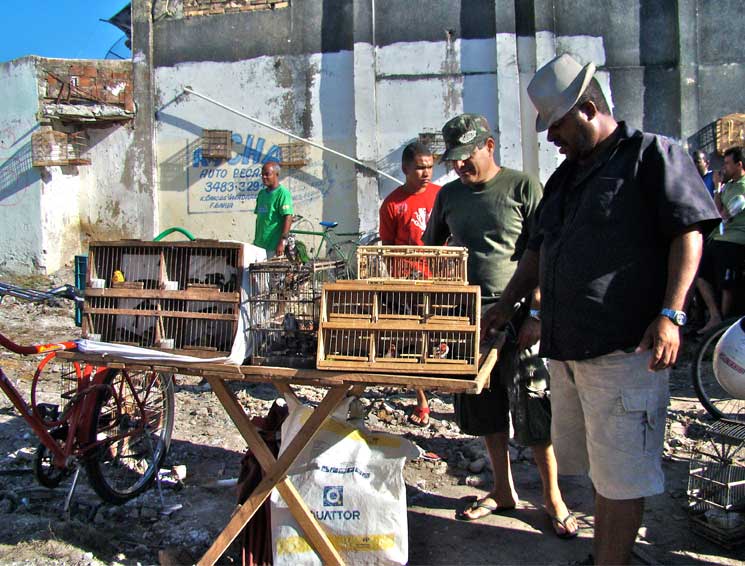
Juliana Machado Ferreira moves quickly through the chaotic sprawl of tables and stalls at Vila Mara, one of São Paulo’s busiest street markets. The vendors hawk shoes, clothing, piles of ripe tomatoes, mangoes and other produce, household items made from cheap plastic, and various sundries. At least that’s what is immediately obvious.
Machado Ferreira is tailing a small group of men who move towards the interior of the market, each of them hefting a large, bulky duffle. Suddenly the men take off running, and she jogs after them.
She brings down the nearest one, though he’s a big guy and the slim woman is a fraction of his size. Plainclothes cops swarm in and handcuff the men while more police storm into the center of the market. There, they target and arrest others. Some perpetrators bolt down the streets that radiate out from the market, tossing their goods into garbage cans or under vehicles, but nearly a dozen police cars block the roads and there’s nowhere to run. They’re captured, and officers search the area to retrieve what they’ve tossed away.
The Vila Mara market has a notorious reputation for selling a wide range of stolen goods and assorted contraband, including illegally captured wildlife. Tips from informants prove effective: when police open the bags and cartons, they find cages, wooden crates and cardboard boxes stuffed with brilliant tropical birds, prehistoric-looking green iguanas (Iguana iguana) and other lizards, and Arrau River turtles (Podocnemis expansa). Some are species that barely hang on in their Brazilian habitats at the edge of extinction.
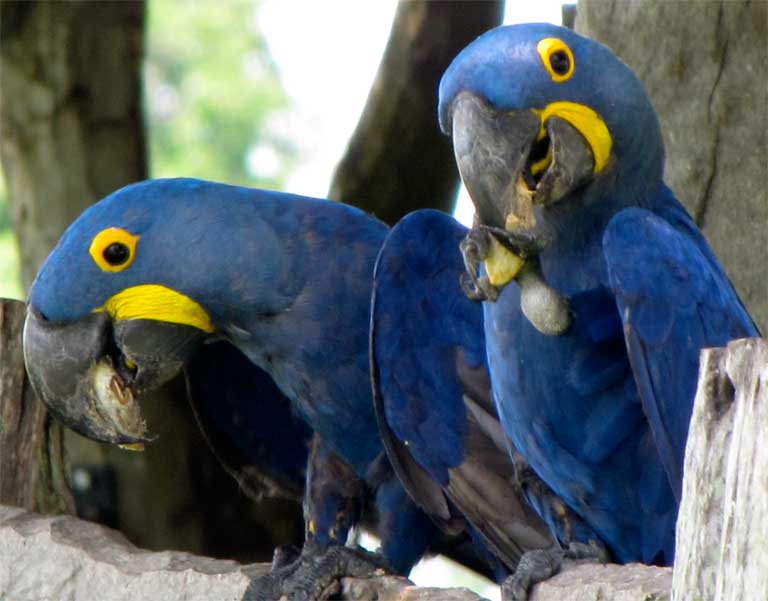
Machado Ferreira joins the 20-some officers who sweep the area, and they find animals sweltering in hot cars and stashed in houses: sellers don’t bring all their goods to market. In the end, they confiscate 185 animals. The majority are birds, which are the most traded animals in Brazil. (Little data exists on environmental crime in the country, but a study published in 2012 found that birds comprised 24 of the 30 species most frequently seized by the Brazilian Environmental Protection Agency from 2005 to 2009.)
38 million victims annually
This haul matches the demographics for wildlife scooped up in other similar raids. The majority of seized animals are young. Some are dead; others lie limp, injured, sick, missing scales or feathers. All the survivors are dehydrated. Most have changed hands multiple times since being grabbed from their homes in the wild. Transport is often grueling: animals are stuffed in bags that are bunjied onto the back of a motorbike, stowed in storage bins under buses, or tossed in the trunk of a car, sweltering in the heat. Birds’ beaks are often taped to silence them; baby turtles have had their heads and feet taped inside their shells and are often piled into tube socks.
Machado Ferreira is part of a team that examines the animals and offers medical treatment. But it’s Sunday (most market raids happen on weekends), which means that these creatures won’t get veterinary care until Monday morning when state triage centers open. In the meantime, the birds, turtles and other creatures will be transported and stored at a police station, a warehouse; they’re sometimes sent to animal welfare organizations. Without sustained care and proper diet, many more will die, and fewer still will have the chance to be returned to their homelands.
This sting, which took place in 2009, was one of the first and largest operations that Machado Ferreira has participated in to date. It was masterminded by law enforcement agencies working with SOS Fauna, a nonprofit organization that works undercover to fight illicit animal breeding and trafficking in Brazil, provides first aid to the victims, and tries to ensure, when possible, that confiscated animals are released back into the wild.

It’s a massive mission. Brazil has the greatest variety of creatures of any country in the world and at least 627 of its species are endangered. This broad biodiversity translates into easy money for underworld crime networks that also run illicit drug, gun and human trafficking operations.
More than 38 million animals are pulled from Brazil’s jungles, grasslands, forests and wetlands each year, according to estimates by the Brazilian National Network Against the Trafficking of Wild Animals (RENCTAS) — and that’s not counting tropical fish or invertebrates. About four-fifths of those animals are birds, thousands of which are babies plucked from their nests.
After capture, animals are passed from local traders to middlemen and ultimately to large Brazilian and international dealers. A study by RENCTAS found that 40 percent of Brazil’s estimated 400 criminal rings smuggling animals are also involved in drug trafficking and other criminal activities.
The country’s black market wildlife trade is valued at a whopping $2 billion a year, according to the Brazilian Institute of Environment and Renewable Natural Resources (IBAMA).

The sheer numbers of animals seized annually overwhelm the nation’s poorly-funded rehab centers, so confiscated wildlife is parceled out to commercial breeders, conservation organizations, sanctuaries, zoos, or even private individuals. Some are put down, and organizations including the Brazilian Ornithological Society propose euthanizing all animals that are not endangered species. It’s a policy that could kill 26,000 birds each year just in São Paulo.
Fighting this trade in hubs like São Paulo is the equivalent of a whack-a-mole operation: catch someone here, and another pops up somewhere else. “There are markets like this in literally every city in Brazil,” Machado Ferreira says, but most wildlife is sold in the big cities — São Paolo and Rio de Janeiro.
Sales have grown more covert over the last few years as law enforcement agencies place more attention on environmental crime, says Fabio Costa, a forensics expert with the Federal Police in São Paulo. More smugglers are selling from their homes or moving their operations from warehouse to warehouse to avoid detection.
Feeding a greedy domestic, tourism, and global pet market
Wildlife in Brazil is hunted or captured for one of four reasons, including domestic consumption, either for meat or medicine. Brazil has a long history of traditional medicine that incorporates a veritable Noah’s ark of animal products — indigenous cure-alls have long been melded with African medicinal traditions brought into the country by the four million slaves transported to Brazil by European colonists.
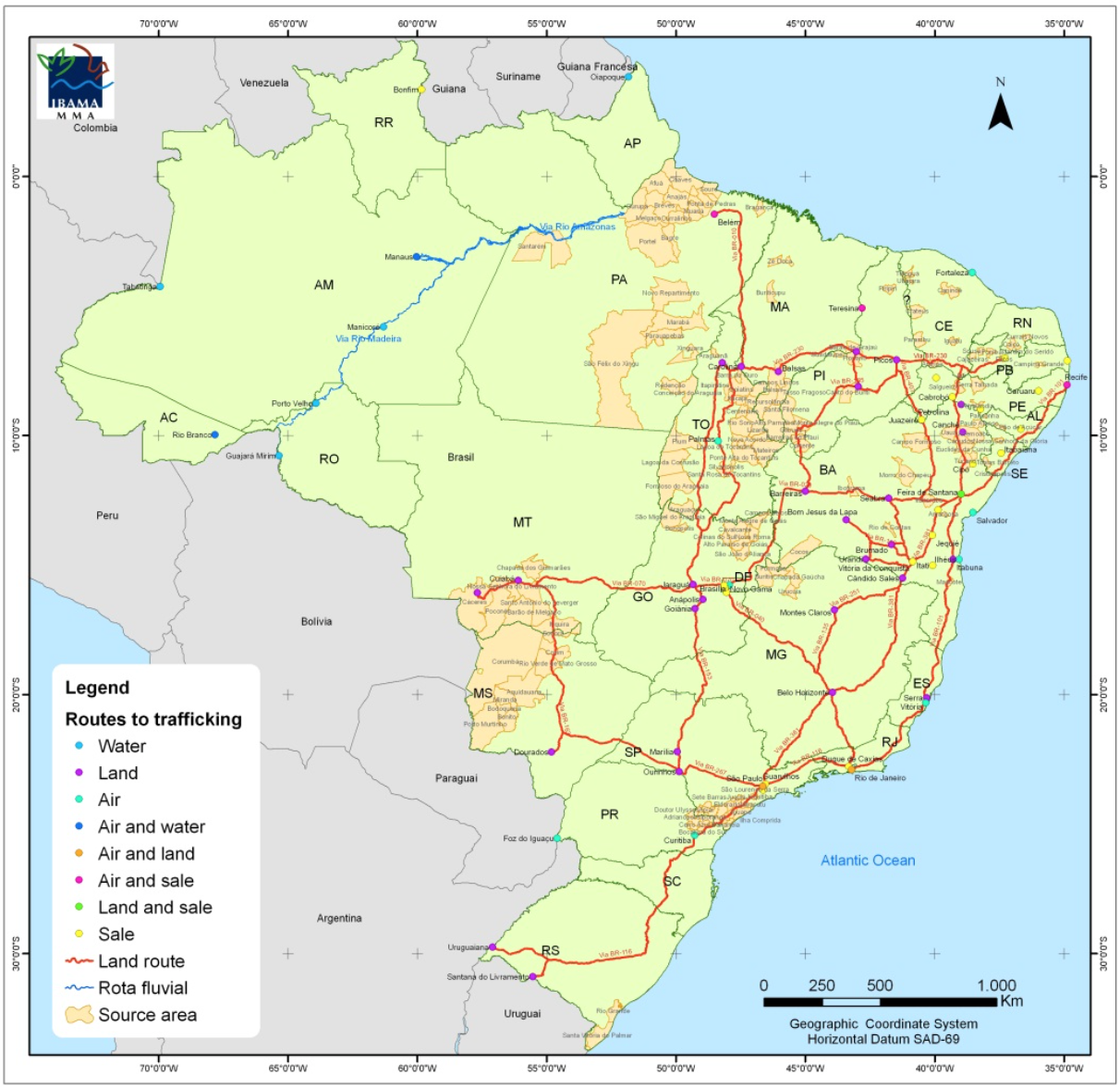
When scientists surveyed markets back in 2007, they counted 283 species that were used to treat everything from insect bites and asthma to cancer, animals that included emerald tree boas, seahorses, beetles, and the Brazilian tapir. Nearly all were wild-caught and 75 of these “medicinal” species were endangered.
Animals are also killed and sold in Brazil in parts as souvenirs or trinkets: jaguar pelts; brilliant parrot feathers; teeth or bone used in religious rituals; stuffed sea turtles or caiman; caiman-skin boots, wallets, and purses; tortoise shell hair combs and jewelry; and fashion accessories made from skins, seashells and various other animal pieces. The production and sale of such items is embedded in tradition, and not considered a crime by most. It’s common to see police walking through markets where these things are sold — taking no action against the purveyors.
International tourists buy these items, too. Most don’t realize that purchasing and taking home these things in their luggage could carry serious legal consequences — but customs officials detect very little of this trade.
Other Brazilian traffickers target sales to scientists and “bio-prospectors” — those hunting for new medicinal compounds from natural sources; venomous snakes and spiders, frogs and insects are particularly coveted for this purpose.
But it is the illegal pet trade that takes the largest toll on the country’s wildlife.
Inside the pet trade
Unlike many other countries, Brazil has a massive domestic pet market for wild animals: more are sold within its own borders than smuggled abroad.
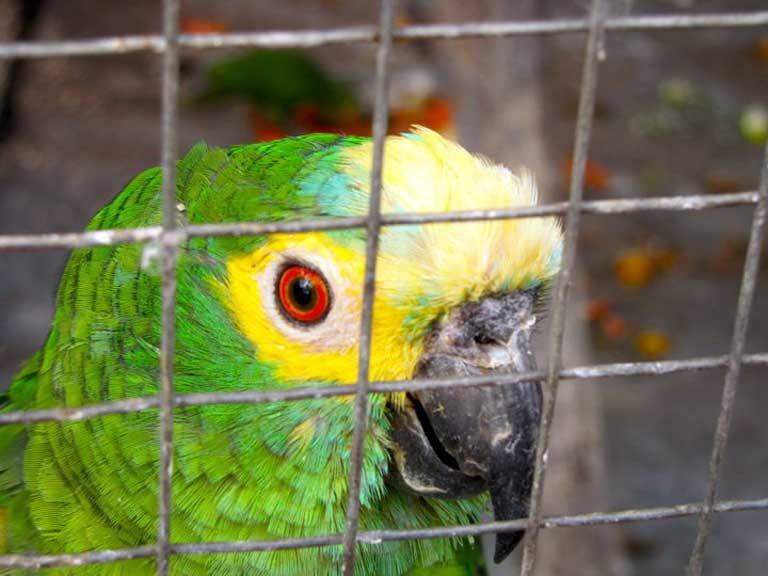
Brazilians have a centuries-long history of keeping wild animals as pets, especially birds and monkeys, calling them xerimbabos: “something beloved.” Machado Ferreira notes that “It’s part of our culture to own parrots, songbirds and macaws.” Among the most desired are those with brilliant plumage and lovely voices, like the green-winged saltator (Saltator similis), a type of cardinal, and the yellow saffron finch (Sicalis flaveola). There are even those who keep pet jaguars.
Lots of other native species end up in tanks and cages in people’s homes, from green iguanas and pink-furred tarantulas (Typhochlaena amma) to various types of boa constrictors, maned three-toed sloths (Bradypus torquatus), hand-sized tufted capuchin monkeys (Cebus apella), the honey-colored Brazilian three-banded armadillo (Tolypeutes tricinctus), and fresh and saltwater tropical fish.
Some of those animals are smuggled abroad to the U.S. and Europe. The rarer the animal, the more it’s in demand from private collectors — despite restrictions on cross border trafficking under the Convention on International Trade in Endangered Species (CITES), a treaty signed by 181 nations that regulates that trade. Smugglers are at risk at both ends of the journey: Brazil, the European Union and U.S. all have strict laws prohibiting import of illegally wild-caught birds and other species — though Brazil is far weaker on enforcement.
Eggs or hatchlings are often carried through international airports by human “mules”; trafficked by ship into seaports in Southwest Europe or the U.S.; or smuggled through the Americas and across the U.S.-Mexican border by truck, car or other ground transport.

In 2011, authorities detected a new trend in smuggling: 16,000 fish were intercepted at Heathrow Airport that carried liquid cocaine valued at 4.5 million: the cocaine was dissolved in fluid inside plastic pouches that were then stitched into an inner bag holding the live fish — which included arowanas, fish native to the Amazon.
RENCTAS estimates that somewhere between 75 and 90 percent of smuggled animals don’t survive capture and transport, but criminal incentives remain high. Drug traffickers work within a similar model: despite a substantial loss of “goods,” selling wildlife brings a hefty profit.
A report presented to the U.S. Congress estimated the value of some animals that are commonly confiscated at American entry points. One of the most valuable was the metallic blue Lear’s macaw, a heavily hunted bird that subsists in a few small scraps of habitat in easternmost Brazil. With perhaps 1,200 remaining in the wild, collectors pay up to $60,000 to own one. Other, less endangered macaws bought for a few dollars in the Amazon rainforest may sell for $2,000 to $3,000 in Europe. Iguanas can sell for $10,000 apiece.
Staunching the flood of traded animals
A major loophole within Brazilian law makes effective enforcement difficult. On the one hand, federal statutes say that “To kill, to pursue, to hunt, to trap, to use specimens of the wild fauna, native or in migratory route, without the due permission, license or authorization of competent authority, or in disagreement with it constitute crime.” But on the other hand, the law allows captive breeding — an easy way to illegally capture and process animals.

Well over 1,000 commercial wildlife breeders held licenses from the environment ministry (IBAMA) to sell animals when they were last tallied five years ago. This legal market very effectively “launders” animals pulled from the wild through a plethora of methods, says Costa.
Certificates are faked and duplicated, registered leg bands are counterfeited — and then there are the fraudulent customs declarations and bribes. On top of that, Costa says that enforcement personnel or customs officials often don’t know the difference between captive bred and wild-caught species.
Lack of personnel is another huge problem. IBAMA runs one understaffed Wildlife Center in each Brazilian state; each is tasked with managing, licensing and inspecting hundreds of breeders, traders and zoos. While there are many dedicated individuals working at these centers, there is no way that they can meet the demand. Funding constraints mean that they often don’t have vehicles or gas to go out on inspections. “Monitoring” comes in the form of yearly reports from the breeders who self-tally their animals in documents that often contain dubious statistics — or are never filed at all.
Wildlife breeders have huge incentive to cheat: while their overhead can be high, so are their profits, while in-country trafficking risks are very low.
![“Many times the conditions we find in seizures are far from what we consider the minimum acceptable [animal welfare standards],” said Machado Ferreira. Photo by Juliana M Ferreira](https://imgs.mongabay.com/wp-content/uploads/sites/20/2015/10/03141853/12-brazil-traffick.jpg)
Animals bred in captivity require a larger financial investment than those snatched from nature, says Machado Ferreira, who now heads Freeland Brasil, an anti-wildlife trafficking nonprofit. She’s working with partners to try to assess the scope of both the domestic and international trade because there is no existing database.
Although Brazilian fines can theoretically top US $50,000, wildlife trafficking is routinely ignored and penalties for environmental crimes are generally soft, says Costa. Even when traffickers are apprehended, they usually pay small sums, which is considered a minor business expense — or in large cases, they often do community service in lieu of jail time.
The only way there’s serious prosecution, says Costa, is if sellers are simultaneously arrested for other crimes and rack up additional, more serious charges for money laundering, carrying weapons, driving a stolen car or selling drugs.
A call to take wildlife trafficking seriously
Traditionally, environmental crime has ranked low on the list of priorities in most countries. But now, there is a global clarion call to fight this lucrative, black market trade, which helps fund terrorists in Africa, and provides income to international crime syndicates and drug-dealing cartels. Globally, wildlife trafficking is now estimated to be a $19 billion annual business.

Last summer, the United Nations General Assembly urged its Member States to take decisive steps to prevent, combat and eradicate the illegal trade in wildlife “on both the supply and demand sides,” calling wild animals and plants an “irreplaceable part of the natural systems of the Earth.” In September, the UN adopted new sustainability goals that address illegal wildlife trade.
With attention from the UN Security Council, the UN Environment Program, the UN Office on Drugs and Crime and other organizations, many countries are now on high alert and cooperating with nations that share their borders.
“We see this vile trade forcing endangered species to the very brink of extinction,” said Helen Clark, Administrator for the UN Development Programme in September. “We’re seeing trafficking and poaching reducing biodiversity, destroying fragile ecosystems, threatening lives — taking lives,… fueling corruption and undermining governments.… To turn the tide on something of this magnitude, a global response is going to have to be much better — and all possible support needs to be provided to the countries and the communities which are on the front lines.”
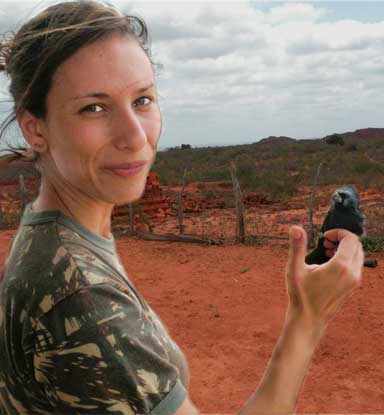
To date, discussions of wildlife trafficking have focused mainly on the elephants and rhinos that are being slaughtered in massive numbers across Africa. But wildlife trafficking is a problem for innumerable species across the globe — and the Latin American trade has been largely overlooked so far.
To address that problem, Freeland Brasil has become part of a coalition that’s forging the new South American Wildlife Enforcement Network (SudWEN), It is working with law enforcement and prosecutors across eight countries to battle poaching and illegal trade in wild animals, marine species and plants, including illegal logging.
Closer to home, the São Paolo prosecutor’s office is organizing a national task force that will align military and federal police and environmental agencies in the fight against wildlife trafficking. The prosecutor’s office is also launching an environmental crime database to help bring about stricter penalties for repeat offenders.
The plight of trafficked Brazilian animals
Most of the severely traumatized animals seized by customs officials and police will never again roam or fly free through rainforest, grasslands or marshes. Only one-quarter to one-half of confiscated animals are re-wilded. The rest live out their lives in captivity, sometimes under very poor conditions; some go to zoos, some end up with commercial breeders or just about anyone who will take them. Many don’t survive.
Repatriating animals isn’t simple or cheap. While some poachers are caught in the act, most animals are confiscated far from where they were taken, so it’s impossible to know where they came from. Even if an endangered animal lives within a fairly limited range, it’s return to the appropriate habitat is complicated.
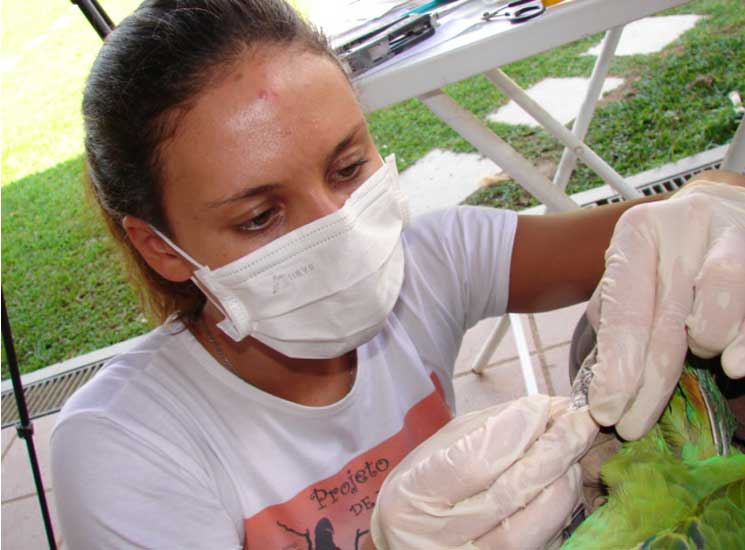
An example: At a checkpoint in Quadra, west of São Paulo, police discovered 192 true parrot chicks (Amazona aestiva) in the trunk of a car. A year later, an unknown number of the 100 birds placed with one veterinarian had died and the 20 received by another vet had been stolen. Three of the birds that SOS Fauna had fostered had died, but their remaining 69 were ready for release. The birds are native to the state of Mato Grosso do Sul, but it’s a big state — rescuers had to decide where the seized birds would be able to thrive and where they could be released safely without fear of immediate recapture. In this case, undercover intelligence pointed to the location where the parrots were originally captured, and the birds did well after release.
Machado Ferreira’s graduate work was in conservation genetics, and she’s using that expertise to help determine confiscated birds’ native territories. As animals adapt to localized living conditions — by growing extra feathers to survive in cooler, higher altitude temperatures, for example — they may develop unique genetic markers. Those markers provide a scientific way to infer where animals may have originated, and to determine where they should be released to give them the best chance at survival.
Currently, most of the healthy confiscated animals that are released by the Brazilian government are let go without much regard for habitat. Machado Ferreira notes that releasing these animals without knowledge of their geographic origin can prove deadly. Being dropped off in a new “neighborhood” can expose these animals to new diseases. They may also carry new germs or parasites that will infect wild populations — or may transmit them to humans. Or their intrusion into an alien habitat may disturb the existing social structure and negatively affect breeding.
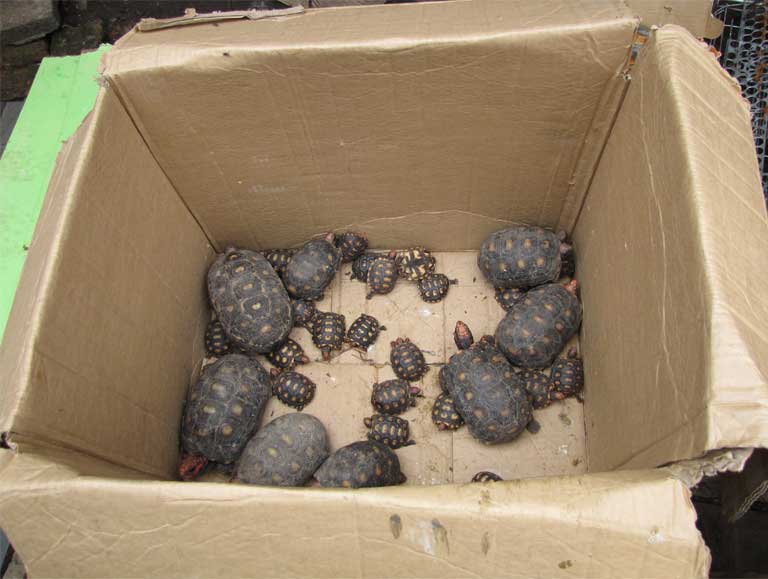
Pulling thousands of animals from an ecosystem causes immeasurable damage. There’s the pain and trauma suffered by millions of individuals, most of whom ultimately die, but there are broader implications. Diminished wild populations may become inbred — with a limited gene pool, remaining individuals become weak and susceptible to hereditary diseases. Heavily-hunted and trafficked iguanas, birds, turtles, or monkeys may completely disappear from a region — or be poached off the planet.
The harm done to one species by trafficking can ripple outward to damage the wider habitat. Removing some or all of one key species can unbalance an entire ecosystem. For example, losing a particular bird species that eats certain fruits — and disperses those seeds — can threaten that fruit tree species and all the plants and animals that associate with it, disrupting natural systems that have been fine-tuned over millennia.
What’s most problematic is that many of these ecological relationships are subtle or unstudied by science, so we don’t know which of our actions might most easily shred the web of life.
All living things, including humans, depend on these delicate living systems, notes Machado Ferreira. “Our agriculture, our water depends on a healthy ecosystem,” she says, and in Brazil these natural systems are already being ravaged as climate change drives escalating drought; forests are leveled for plantations, ranches, infrastructure and other development — and 38 million wild creatures are pilfered every year to sell across the country or the world, mostly as pets.
These are wild animals, says Machado Ferreira that we should not regard as pets at all. “Wild species are supposed to evolve over time as dynamic entities in ever changing environments. [They’re] not [meant] to be someone’s amusement.”
